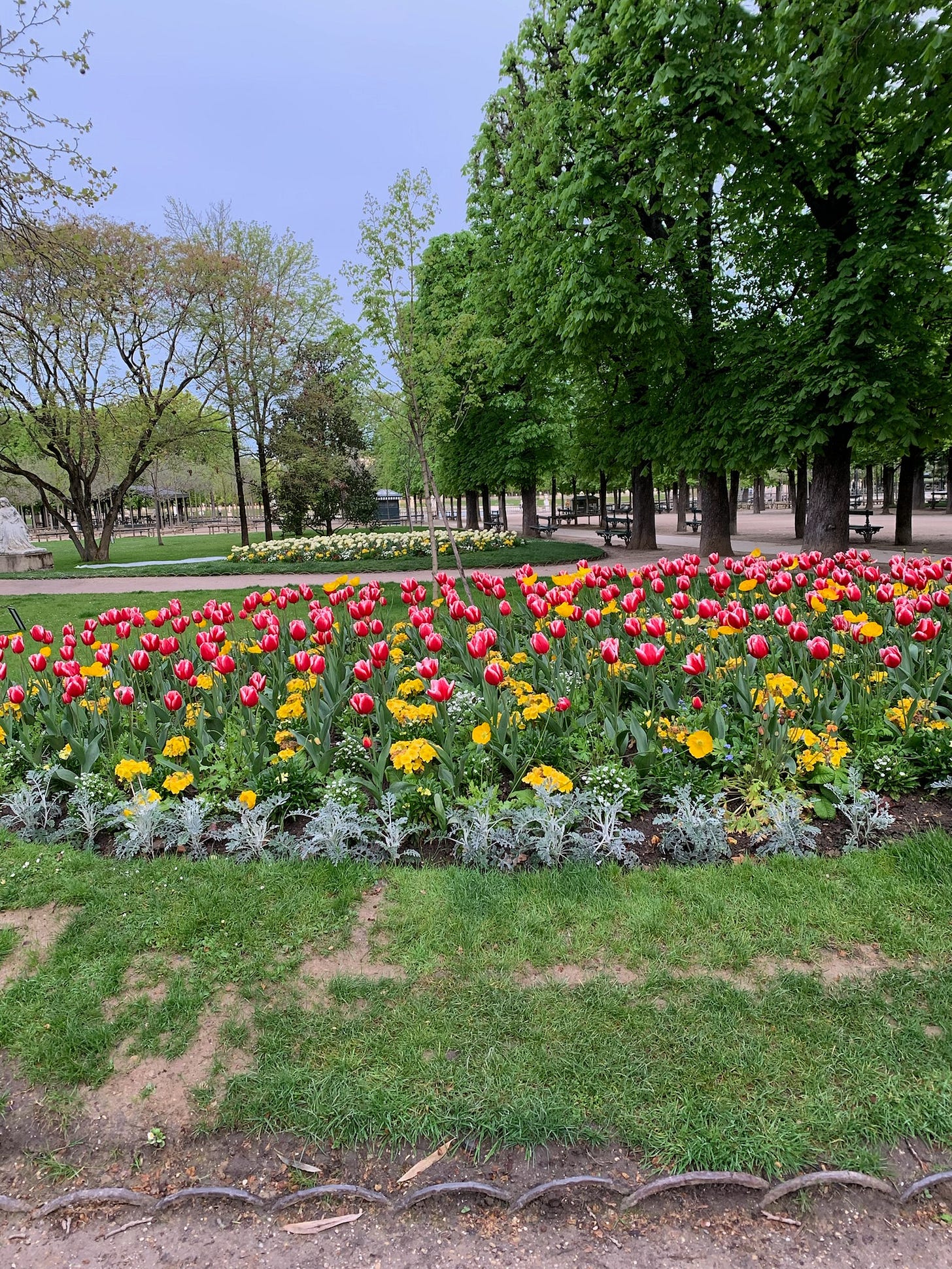More parks and green spaces....
Parc de la Villette, Coulée Verte, Jardin Atlantique, rue Mouchotte
The other day I came across some bits and pieces on Paris parks in the “drawer” of my computer that hadn’t made it into an earlier post on the Luxembourg Gardens. I’d been thinking about how different Golden Gate Park is from parks in Paris, and how I love them all. They couldn’t be more different, but I wouldn’t say I prefer one to the other. Part of this not preferring is intentional: I try to follow my own advice about not making better/worse comparisons between different cultures and environments.
The biggest contrast is that nearly all Paris parks are gated and San Francisco parks are not. You can run (or walk or bike) at any time of day or night in Golden Gate Park, whereas early morning runners in Paris have to stick to the sidewalks surrounding the Luxembourg Gardens, Tuileries, and other parks until the gardeners open the gates. To make it more complicated, opening and closing times change as often as every two weeks as the days lengthen or shorten. I know of only three ungated Paris parks, two of which are called a forest rather than a park: the Bois de Boulogne on the west side of the city and the Bois de Vincennes on the east. The third is the lovely Parc de la Villette, home to the Paris Philharmonic, the Paris Conservatory of Music and Dance, various art and exhibition spaces, and more. Although a fraction of the size of the two bois, Villette is the largest “cultural park” in Paris. It’s a bit off the beaten path (north-east of Place de la Bastille) and therefore not on most tourist itineraries, but I highly recommend it on a nice day — particularly by bike, as you can cycle up the Canal Saint-Martin which becomes Canal de l’Ourcq along the park. I had meandered around Villette a number of times over the years, vaguely wondering about the odd-shaped red structures scattered throughout the park. Thanks to Le Nouveau Programme, I not only learned about these buildings, but also about the trajectory of this swath of land from stockyards to urban oasis, and about the fascinating architect, Bernard Tschumi, who won the 1983 competition to develop the park.
La Villette is rather far from our apartment, not a place I can just drop by. The parks I most often visit during my runs are Jardin du Luxembourg, Jardin des Tuileries, and Jardin des Plantes. There’s also the Paris version of New York City’s Highline, called the Coulée Verte, on the right bank, which is often part of the route taken by our running group, Let’s Run Paris.
This sign on a wall of the Coulée Verte says, “This space is for walking. The practice of jogging is tolerated as long as it doesn’t annoy the walkers.” So French.
The Jardin Atlantique, aka our backyard, is a public park located on the roof of the Gare Montparnasse. The station was enlarged and upgraded in the 1960s, around the time the Mouchotte building was built, replacing three smaller stations. It’s certainly handy for us. We can roll out of bed, take the elevator down, go out the back gate, and be on a train five minutes later.
Nearly every nice day, we spend some time in our backyard, reading on a bench. The Jardin includes many allusions to the sea and the coastal areas, perhaps because trains from the Gare Montparnasse go to destinations along the Atlantic coast, including Brittany, Bordeaux, Biarritz, and San Sebastian. The theme of a sailing ship appears in the lampposts that resemble masts and in the elevated wooden walkways that are intended to evoke a ship’s bridge. There are a number of thematic gardens containing different vegetation, my favorite being the “Salle des plantes ondoyantes” or “Room of undulating grasses.” The tall buildings surrounding it block the street noise almost entirely, and all you hear is the occasional conductor’s whistle signaling a departing train from underneath the park. Compared to the grandeur of the broad allées in the more famous Paris parks, the Jardin Atlantique is quite modest, offering an inviting spot to rest for a while, read a book, chat with a friend. Many of my Parisian friends had heard of it, but never visited, and I doubt you’ll find it in most guidebooks. Sorry, but there’s no cafe.
Due to the increasing temperatures caused by climate change, summer in European cities can be tough. In Paris in June, the sun doesn’t set until well after 10pm and nobody has air conditioning. Tree cover can lower the temperature of a city by several degrees but, according to this article from the World Economic Forum, Paris ranks well below the European average with only 20% of the city under tree cover. Our friends in the 17th arrondissement live on a street with not a single tree. Fortunately, planting more trees is one of the many “humanizing” projects currently in the works by the current Mayor, and their street is on the list.
Since the beginning of this year, our street, the rue du Commandant René Mouchotte (try saying that three times fast), has turned into an enormous construction site. It probably won’t be finished for another year (summer, 2026), but we’re starting to see where it’s headed: broader sidewalks on both sides of the street, protected bi-directional bike lanes on one side, narrower vehicle lanes, and a wide green pedestrian strip down the middle with lots of trees. Here’s an article (in French) on the restructuring and greening of our street. I can’t wait.











Ruth, "shares" so vividly describe your days in Paris! We will miss you @ the Stampede but there are other races here to share with you. Knee surgery in July after Iceland, and then it will be a wait and see! The 70+ers are waiting for you.